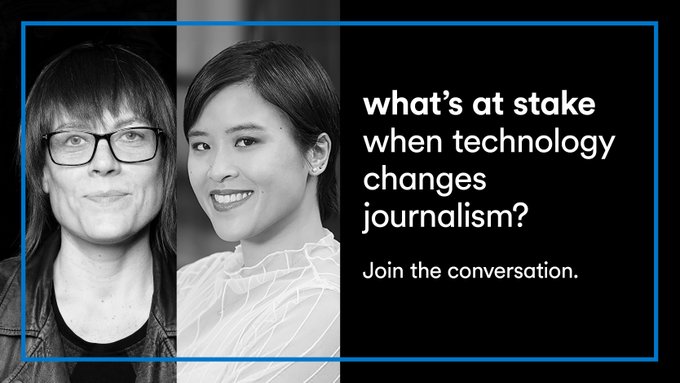As we move deeper into a digital age, the way we engage with media – and the way it’s produced – is changing. What are the benefits, and the drawbacks, when technology intersects with journalism? How do these changes in journalism impact what we consume, and how we consume it? And how will technology continue to influence our access to information?
Katie Drummond, Global Editorial Director of WIRED, joins Anita Li, freelance journalist and CEO/Editor-in-Chief of The Green Line, to share insights into the evolving world of journalism.
WIRED stands at the forefront of exploring how technology transforms our lives, and Drummond has been instrumental in guiding the magazine through its digital journey. This collaborative event with the Toronto Public Library explores the innovative tools reshaping storytelling while broadening audience engagement and considers the intersections of technology, culture, business, and design.

Anita Li (A): You’re covering the U.S. presidential election, and you said that you’re viewing politics through a tech lens. I’m curious to hear what you mean by this exactly, and your thinking behind this strategy.
Katie Drummond (K): Sure, yes, we do have an election coming up in November, in the United States. WIRE has a legacy of, ebbing and flowing, of getting into politics coverage, and then pulling back from politics coverage. When I started my job I learned there were several journalists across technology, business, consumer tech, science, internet culture etc.; but we did not have a politics team, and so I sent my boss, , an email that morning, outlining what needs to be done to build a political team
In late 2023 after I sent this memo my boss Anna Ridgeworth telling her that there is a historic election year around the world with more national-level elections this year with Mexico, Russia, Ukraine, India will have an election. It was then that I was able to build this politics team, and hired some journalists, who are based in the United States and in Europe, to cover politics in the WIRED way specifically mediated politics is now by technology
The importance of a candidate’s presidential campaign showing should not only be shown on broadcast television, but on Twitter, on Facebook, on TikTok. The Biden campaign launched a month ago is obviously intricately interwoven with technology. In order to cover these in WIRED, we need to cover decisions that are happening in the political realm, particularly as they pertain to technology. So we hired reporters who could cover online campaigning, and the online candidate.
We had to think what it means to be a candidate for office in the year 2024, how does that manifest itself on the internet. We needed to hire a reporter in a very remote, undisclosed location to cover online extremism in the far right, covering how these communities are percolating, what they’re talking about, and what they’re doing. We also needed journalists to report on election denial groups with large groups of people who think that the 2020 election was stolen, and that already the 2024 election is on track to be disruptive. Webinars are being held to convene in online forums. Tools were being developed to compare voter registration tallies with postal service data about people’s names and addresses, to be able to allege where the vote was stolen and if a vote was incorrect.
We can’t talk about anything right now including politics, without talking about artificial intelligence, and so we’re very focused on how generative AI’s quickly developed tools, just exploded in the last year and a half, have the potential to be used, and abused, in terms of sowing chaos in an election cycle. That was made using generative AI technology, developed by a very mainstream, VCfunded startup out of Silicon Valley, that was weaponized to try to create chaos. I think we are very well positioned to do that coverage in a really smart way, with a lot of expertise around how this technology is actually shaping this election. I feel a journalistic responsibility to cover it, and given where I work, and what we cover.
A: I think you set the stage beautifully for the rest of our conversation, and we will be getting into AI in depth later on. In our pre- conversation, you mentioned about how the Biden campaign is actually giving greater media access to influencers over traditional media. Please tell some of the stories that are going to be coming out of WIRED in the next little while.
K: Yes, this was interesting to us. These campaigns, the Biden campaign, among them are becoming very savvy about how audiences consume information, who they trust, who they listen to, and who they don’t.
There is a real recognition among political campaigns, and even among the media, that audiences, particularly younger audiences, or voting demographics, are less inclined to go to a news outlet than they are to their favorite person on TikTok. The Biden campaign has been trying to get the message of its campaign out to the audience on these platforms, where you have a big, sort of organic audience.
Whereas all of the press was shuttled off into a press room, the influencers who were invited were given wonderful treatment by the Biden campaign. This reveals how these influencers are being utilized by various campaigns. I think Robert F Kennedy Jr is an interesting person to be watching in the U.S. election right now. He is the most popular independent candidate to run for federal office in the U.S. since Ross Perot a long time ago. Very much being an online candidate, he has tapped that influencer network to get his very conspiratorial, and inaccurate messaging out to an electorate. He himself is playing this interesting role as an online influencer, whose TikTok account has multi-million views on these videos that he’s putting out. This is because he has taken the influencer playbook and applied it to himself as a candidate. This notion of how with Journal of the Met at WIRED, we adhere to a set of standards and principles and values, whereas we’re leaving it to influencers.
A: What does that say about the nature of the information that gets disseminated?
K: We need to understand reality to have a strong democracy. The way these platforms like TikTok work is a little unhealthy. But I exist in my own little TikTok world that the algorithm has discerned, this is what she’s, from eight to 9 p.m. most nights, this is what her experience will be, because that’s where you will find me. My husband is here, and he knows.
When you think about that in the context of politics, and the information, or misinformation, or complete lack of information that someone might get, because of how these algorithms work. They are designed to give you things that you will like, so that you will spend more time there. On the one hand there is information provided by a news organization, with journalists trained to report, analyze, and then disseminate it. But on the other hand, the information you are getting is whatever your TikTok algorithm thinks is interesting to you.
A: You mentioned that this is obviously an unprecedented time to cover current politics, or any sort of issue these days. You’ve worked at VICE, Bloomberg, Gizmodo. What did you bring from those experiences to your current role, from both editorial and business standpoint, because as we know, this is a time, and era, when media industries worldwide are struggling financially.
K: Editorially, I think I have brought a few things. I think that I have gravitated towards news organizations that have a streak of fearlessness in them. I think that you need to do the coverage that is important, and you need to be fearless. Gawker Media, whatever you thought of the coverage they did, they did it without fear or favor. Same with VICE, we went to places that other journalists did not go. We did it carefully, thoughtfully, and intelligently, but we did it. We went where we needed to go, we said what needed to be said, and I think the execution on that is something I’m really, proud of.
When you look at my resume you would notice that most of the news organizations that I have worked for no longer exist. Journalism is something that would be very, very hard, if not impossible, to replace in this media ecosystem. And so those experiences and seeing how fragile this industry is and how quickly journalism that audiences come to love and trust and know can disappear.
The journalism that VICE journalists did, hundreds of them, around the world, in Asia, across Europe, in Latin America, across the United States, in Canada, it just doesn’t exist anymore. It has disappeared. So, it has given me a real resoluteness and an obstinate stubbornness to make the business of journalism work. And I came into WIRED feeling very strongly about that. We needed to figure out a business model for this specific publication that will allow me to sustain this. So that is something that I spend time on.
I would love to say I spend 100% of my time working on journalism. But I probably spend 45% of my time working on journalism because I spend the rest of my time making sure that we’re making money. And I don’t want the journalists who work for me to be worried about that.
It breaks my heart to think that they might be worried about that. I want them to be worried about the election. I want them to be worried about the stories that they are trying to get on the page.
A: Absolutely. What are you experimenting with in terms of revenue and how are you innovating in that space? Like you mentioned, you guys all obviously heard the news about the thousands of layoffs at El Media. So, this is impacting everyone worldwide. So how are you maintaining or staying at the cutting edge of that?
K: Yes. I wish that there was a silver bullet for any organization. But this isn’t. Leaders in this industry are not only thinking about the news and the journalism, but who are thinking about the bottom line, I think that’s one big piece of it. And then I think for an outlet like WIRED, there are so many ways that we can make money. And so, my point of view is, we should not have one way.
I think that was, for VICE, the real challenge because it was 90 some percent reliant on advertising revenue. And so as soon as that went away, it was game over.
For WIRED, also about half of our business is advertising. And it’s about sustaining that business. And then we are building a consumer revenue business, which is a fancy way of saying subscriptions, asking people to pay for journalism.
We are building a subscription business for WiIRED and really thinking about different tiers of that. That’s one place where we’re really experimenting by bringing back the idea of forums where people can comment on articles interacting with WIRED journalists in that capacity.
And as for our commerce business, we have some of the best product coverage and that is a source of revenue for us.
If you read a review of a new phone on Wired’s website and you decide to buy the phone, we monetize that. This layer of thinking about our business going forward is really driven by the community. It’s about finding those loyalists, finding those people who love WIRED, who want more of WIRED, and then giving them opportunities to spend time with us, whether it’s in-person events, a digital kind of live stream events where they can ask our journalists about their most recent cover story, or whether it’s the chance to write your own product reviews on our website and share your point of view on a product that we also reviewed.
There you can play with and test out and try. And I do feel very lucky to work at a company where we have the infrastructure and support.
This race for scale in digital media and the reliance on advertising that was built up through that process. And then as soon as the bottom falls out, and as soon as Facebook and Twitter decide that they’re not going to promote our news stories, suddenly, no one’s clicking on your website. If they’re not clicking on your website not seeing your ads. Suddenly, you don’t have a business. So, it’s really about trying to free ourselves from that reliance, which I think, is a real misdirection for the industry.
A: You have WIRED heads of custom from the Czech Republic, Slovakia, Italy, Japan, Korea, Mexico, Latin America, the Middle East, the UK, and, of course, the US. And your international reach means that you have to deal with the very ways that tech is perceived and adopted across cultures, which I find fascinating because these markets are wildly different from each other. So how are you ensuring that WIRED journalism resonates across these different landscapes, both editorially, but also from a consumer revenue business standpoint?
K: That’s something I feel really strongly about, and one of the reasons I feel strongly about it is because I grew up in Canada, very proudly, and I was a consumer of a lot of American news. Tom Brokaw, an American retired network television journalist and author was on TV every night. It was a lot about America. So when I moved to the United States and became a journalist and got into management, it was very clear to me that American journalists really tend to spend a lot of time thinking about the United States, and there’s a real sort of self-involvement like it’s the United States. But the question is if you have ever heard of these other countries all around the world where all this really interesting stuff is happening? And at WIRED, we haven’t done enough with the fact that we have a team in Tokyo, a team in Milan, a team in London, a team in Mexico, and they are covering technology and innovation in those parts of the world.
And I am much more interested in figuring out how we collaborate with those teams, translate their work, bring that work to an English language audience, instead of sort of constantly pushing our journalism out into these other parts of the world and just expecting those audiences to think that that’s great. I think it’s much more beneficial for us to introduce innovation and technology and what’s interesting and important and relevant and vital that’s happening in these other places to an English-language audience, and I want that work to be created by the journalists who live and work in those parts of the world.
I think we are just starting to unlock that, like we have just started to work translating stories from our team in Mexico, and our American audience is reading them, which is a positive signal. But as far as a business consideration goes, that’s an important differentiator for WIRED. There are a lot of other tech outlets, very few of them can say that they operate in many countries. I think to not sort of use that to our advantage editorially and as storytellers would be a huge mistake. That advantage then translates to a healthier and more sustainable business because we are able to say we are worth paying for, worth paying attention to because we do something different. We are a global brand in a way that so many other technology outlets and do fantastic work. They just don’t have that reach/ And global audience or global reach really entails. We live in a pluralistic, diverse society and there’s diasporic communities that represent all nationalities in the U.S. and Canada. So I’m sure there’s an audience for even that kind of coverage at WIRED. So this is the point in our conversation where I inevitably bring up artificial intelligence.
A: Great. Just talking about AI these days, I’m really curious how WIRED covers specifically generative AI’s impact on society in a way that informs without resorting to alarmism or sensationalism. You see this binary conversation emerging about AI where it’s the heralding of a new era in technology and it’s just kind of breathless optimism, especially in business sectors. But then also at the same time, you have this really fear-based resistance, including in our own industry as well. I’d love to hear how you guys are approaching this topic. I will say it’s very interesting to work in an industry that feels an existential threat from this technology and that we’ve been trying to cover
K: I work for a parent company, which is like any media company. Like the New York Times is using open AI right now. My own parent company is in conversations with these generative AI companies about how they are using our data, how they’re using our archives and all of the work to train these large language models. So there’s something very connected about it, but I agree with you that I think a lot of the coverage is breathless, it’s hypothetical, it’s lost in the clouds.
It is either we’ll all be dead in 10 years and there will be a robot standing over your body laughing, or we’re all going to be working 40 weeks and it’s going to be so chill and you have never had a better time than when you let this AI take over your job and do all your work for you. The reality is actually it’s, you know, in practical terms, for a typical white-collar worker, it’s like having a smart college-age intern helping out. And they make a lot of mistakes and hallucinate every once in a while.
That’s where we are, just to be clear. Like this is not, we’re not talking like RoboCop, like a crazy future world. That’s how we’re covering it. Which is trying to be very grounded in the here and the now, always with an eye to the future, but I think you start to lose people, you start to lose audiences when you’re just esoteric up here in the clouds like that.
When new iterations of these technologies come out, we have to be really clear about the kind of step changes that have gone, happened from like Llama 2 to Llama 3. Taking Facebook’s gen AI model one has to be practical and clear with audiences and really trying to put a human lens on these stories. While trying to tell stories about how this technology is changing people’s jobs in that industry? What is it doing that is maybe really interesting and exciting over here with say radiology or modern medicine? What is it doing over here in this call center that might be a little bit problematic, making us think that maybe we actually should not have replaced all of these human phone operators with AI chatbots because we just like caused a real problem at this eating disorder resource center, which was a story that we did recently. So really being very interfering now in humans about the coverage. I think on those terms as I am also a real believer in and advocate for accountability driven journalism. That is what we do, that is what I get up in the morning to do.
And again, I think coming back to WIRED’s mission of being in service of a better future is always what I come back to. There’s a real accountability piece when you are looking at these companies that are rushing forward with this technology. They are in a sort of capitalist race to see who can be first, who can be best, who can monetize, who can be number one. And there’s not a lot of discussion or consideration about regulation, about safeguards, about how this might actually affect the labor market. How might this affect people’s jobs? How will this affect education? How would this affect the lives of our children?
Those conversations are notably absent, you know, when you hear from Sam Altman, or from Satya Nadella, or from Mark Zuckerberg. They’re not talking about that. They’re talking about how much better their model is than the other guy’s model.
I think part of our job is to look really critically at these companies, at what they’re doing, what they’re not doing, what they’re saying versus what they’re doing. They will all say, we welcome regulation. We look forward to working with policymakers while they rush out the next version of their large-language model, because these other guys just rushed out their version. It doesn’t end well. We have seen this before. We have seen what happens when technology outpaces regulation, and when kind of no one is really paying attention, and all of a sudden, you know, Facebook has taken over the entire media industry, and they can turn the lights out with the flip of a switch.
That is fundamentally our job. We can be really excited about this technology. We can think from a technical point of view that it’s incredible, and we do think that our journalists do think that. They’re very excited about generative AI and to be using it in the newsroom in certain respects. But we owe it to the audience to be very, very clear-eyed about, you know, what these companies are doing as opposed to what they’re saying.
A: Yes, you bring up a good point about how we’ve gone through this before with social media, and in fact, both you and I have been in the technology media sector for some time. I used to work at Rational, and there was a lot of reckless optimism about social in the mid-2000s to late-2000s. What kind of lessons did you learn in your tenure from that experience, and how are you bringing that to your coverage of AI?
K: Thinking from a self-interested insular media point of view, I come back obsessively. I work with someone who’s fantastic, and he worked at BuzzFeed, and I always remember the time that Facebook gave all these media companies a bunch of money to do live video on Facebook? It was going to be called Facebook Live, and it was going to reach just hundreds of millions of people. And then BuzzFeed everyone was doing the lowest common denominator video coverage that they possibly could to try to get the biggest possible audience. And then Facebook misled media companies about how and why these videos were pulled from the funding, and everybody got laid off. These are hundreds of thousands of dollars or millions of dollars going to these companies, and one of the biggest cautionary tales for me and lessons for me in that, going back to our discussion about business, was if a platform offers you audience and money, be very, tread very carefully in it, because you never know when that funding’s going to get pulled. It’s incredible to think about Facebook’s stated commitment to news 10 years ago to now.
I mean, our traffic at Wired from social media has gone from something from 65% to seven 7%. That is a lot of audience to have to make up as a media company. So, I think that’s the biggest cautionary tale. If there is journalism happening on a platform that you don’t own, that you can’t control, be very, very careful about how you invest in that platform.
I want to reach those audiences. I want to reach the audience on TikTok. I want them to know and love WIRED Journalists and our journalism, but we can’t give away.





